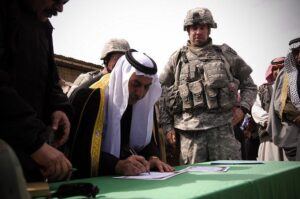If Israel wants to defeat Hamas, they’re going at it the wrong way. This is the conclusion made by my colleague from the University of Chicago, Robert Pape, in a recent op-ed in the New York Times, with which I largely agree. My agreement with Pape is based on years of following the rise and fall of terrorist movements around the world.
Pape’s point is that a terrorist group should be separated and isolated from the general population in order to be targeted for defeat. Any strategy that includes attacks against the general population—including especially killing them and destroying their homes—simply creates more terrorism in response.
Pape gave several examples from recent history in the Middle East to make his point, including the rise of Hizbollah and Hamas. They emerged as direct responses from a broad Israeli attack on civilian populations that created anger and support for the new extremist movements.
The same happened in Iraq after the US invasion. But there was one bright moment in the counterinsurgency there that is worth recalling, since that offers a strategy that could be employed in the current situation with Hamas in Gaza.
In the early 2000s, the US occupation forces in Iraq were confronted with a new terrorist organization, al Qaeda in Iraq. Led by a Jordan militant, Abu Masab al-Zarqawi, this vicious movement utilized the most brutal of terrorist attacks, including beheading foreigners, to trying to drive away the occupying forces.
Initially the US-led military occupation attacked the resisters to the occupation in the conventional way. In 2004, for example, it launched a wholesale assault on the city of Fallujah, virtually destroying it. In response, however, Al Qaeda in Iraq just grew stronger. Even after locating the leader, Zarqawi, and killing him, the resistance movement expanded.
In 2007, under the leadership of General David Petraeus, the US adopted a new strategy. His idea was for the US military to largely withdraw from the Sunni areas of Western Iraq that were the heart of the resistance. Instead, he empowered the local Sunni leaders there to fight against the al Qaeda in Iraq movement, since it was undercutting their own leadership and creating havoc in the Sunni towns and villages. They hated Zarqawi’s movement, and given the chance and the military support, were eager to fight it.
This strategy, known as “the Awakening,” was largely successful. The movement was virtually destroyed and the region was relatively quiet for several years. After the US withdrew from Iraq in 2011, however, the Shi’i led government in Baghdad abandoned the strategy and the Sunni leaders felt alienated. A new radical movement emerged led by some of the former activists associated with al Qaeda in Iraq. This new movement eventually changed its name to the Islamic State of Syria and Iraq—ISIS—that became an even greater force with which the region had to reckon.
This sequence of events indicates that the strategy of arming and supporting a local resistance to a terrorist movement has to be coupled with a long-term strategy of support for the local population. The local leaders have to be empowered to continue to resist extremist movements in the future.
Could this strategy work with Hamas? The situations are not entirely comparable; Gaza, for instance, is a concentrated mass of urban humanity. Still the majority of residents of Gaza before the October 7 attacks appeared to be hostile to Hamas, or at least noncommittal. There was, and is, the possibility of a Gaza-based insurrection against Hamas that could be supported and that might be far more effective in countering the militants.
The first step in this potential collaboration between anti-Hamas Gaza residents and Israeli forces is to stop targeting them as if they were the enemy. That might open the door to a productive engagement to defeat the militant forces, and it might be a step towards a more enduring peace.

